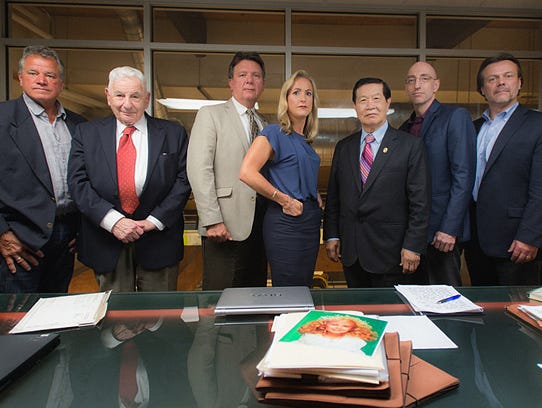
The Case Against ‘The Case Of JonBenét Ramsay’, Here’s 5 Times The Docuseries Fudges The Facts
Last night on Channel 9, the wildly buzzed about docuseries The Case of: JonBenét Ramsay came to an end, and looks like we have found the slain beauty pageant’s killer… well, this is what the program’s investigation would lead you to believe.
Without much doubt, every single facet of the investigation pointed all eyes in the same direction. Towards the verdict that brother Burke Ramsay killed his little sister and the parents Patsy and John Ramsay orchestrated a not-so-sophisticated cover-up.
Unlike more balanced true crime series that have come before the CBS JonBenét television series, the show is entirely subjective and biased towards the case. Led by former FBI agent and criminal profiler Jim Clemente and behavioral analyst Laura Richards, along with ‘star’ investigators with 250 years experience of law enforcement experience, what is largely only educated speculation is conveyed as fact.
While CBS included a disclaimer at the end, that encouraged viewers to “reach their own conclusions,” the style in which the docuseries argues the case – with their final verdict presented neatly on a platter – made this impossible to do so.
There are many issues at fault here, which leaves the series guilty of bias on several occasions.
Here’s 5 times The Case of: JonBenet Ramsay fudges the facts:
1. Selective hearing and confirmation bias in the 911 call analysis

Channel 9
The 911 call by Patsy was the first item of evidence that the team targeted. More specifically an inaudible portion at the very end of the phone call, which is believed to pick up a conversation accidentally aired to the phone operator.
In an effort to decipher the inaudible voices heard during the end of the call, Clemente and Richards use “modern audio technology” to figure out what was said and who was speaking. By enhancing the tape, we are told pretty conclusively that John says, “We are not talking to you,” then Patsy says either “Help me Jesus, help me Jesus,” or “What did you do? Help me Jesus”, before Burke asks “What did you find?”.
This is all demonstrated by projecting their own subtitles across the screen as the muffled words are spoken, to attempt to convince the viewers that they were hearing those words too.
But is that really what was said, or is that what investigators wanted to hear? As a viewer, it’s difficult to hear what they were hearing, and countless alternative sentences could take their place instead.
Selective hearing is a serious factor here, along with confirmation bias, as there is a well-worn tendency to interpret evidence through confirming one’s existing beliefs or theories.
One way to combat confirmation bias, would be carrying out the study by researchers that are unaware of the case, or the context of the segment they are hearing. Someone that can carry out an unbiased audio assessment would be a more reliable source. Rather than a person involved in the investigation, looking for evidence and possibly hearing what they want to hear, in order to substantiate their case.
2. The team dismiss and ignore DNA evidence

Via CBS
The Boulder County District Attorney Mary Lacy’s exonerated the Ramseys in 2008, based on new DNA evidence which revealed the presence of unidentified male DNA on JonBenét’s underwear and leggings.
However, this is very quickly dismissed and ignored by Dr. Lee, who instead just accepts that as it was ‘touch DNA’, it is easily transferred and could have come from anywhere, including the factory the underwear was made.
This tunnel-vision and complete disregard for DNA evidence is a pretty strange move in an investigation. Dr. Lee summarises the evidence as insufficient proof of an intruder or proof of the family’s innocence.
But even if this is the case, does it mean the DNA should be completely discounted? What if years down the line, the DNA matched a known pedophile or murderer in the area? To ignore evidence without exploring its possible usefulness because it’s only ‘touch DNA’ seems irresponsible and something that sets a dangerous precedent for future cases.
3. The conclusiveness of linguistic and behavioral analysis was overplayed

Via CBS
This area of the docuseries was particularly problematic. Featured prominently in the program was former FBI linguistic profiler James Fitzgerald and former FBI statement analyst Stan Burke, analysing the family’s behavior- observing everything from vocal inflections, body language, phrasing and human behavior.
There was some pretty sweeping generalisations being made regarding Patsy’s behaviour and language during the 911 call. In examples of the mother saying oddities like “We have a kidnapping” and referring to herself as “the mother,” these statements are used as confirmation that the phone call was staged. This is subjective evidence, which in most cases would be unaccepted or deemed unreliable in court.
In addition to this, when observing Burke’s interview with a child psychologist, Clemente quickly deems Burke’s response as inappropriate, without engaging in how children deal with grief differently.
He also fails to examine whether they might be viewing symptoms of autism or some form of social disorder, rather than a child covering up a murder. The interactions with Burke were viewed with complete bias, and while Burke’s behavior seemed strange, this is not any real indication of guilt and could be a result of recent trauma.
4. Some of their statements were irresponsible or incorrect

Via CBS
There are examples of the investigation ignoring or underplaying facts on more than one occasion. In one case, when they claim that John disappeared for an hour and a half on the morning of the murder, they miss one important detail- that the Boulder police later found him in his study.
It turns out the police didn’t sufficiently search for the father. Not including this fact was clearly intended to make John look like he was engaging in a cover-up during that time. It’s extremely irresponsible to not include what actually happened in real-time and lay all the cards on the table.
In another instance, we are told that “statements” made to authorities, said that John called out that he had found his daughter’s body while it was still dark in the room and the lights were not on. What is not included is who made those statements. Without this, how are we to know whether they are a credible witness or not.
5. Alternate theories were proved with unreliable reenactments

Via CBS
One of the cornerstones of the series are the reenactments created through rebuilding the Ramsay’s home and the most significant rooms in the case. It is in one attempt to disprove the intruder theory, that Richards tries to get through a replica model of the basement window. By doing this, they find that she would have destroyed a spider-web that was found at the crime scene still intact and undisturbed.
This reenactment is pretty flimsy, as it depends on the intruder being the same shape and size as Richards, and the spiderweb appearing untouched is not exactly binding in the court of law. The intruder could have entered another way, so to say this is solid evidence against the intruder theory is a step too far.
Another theory positing Burke as the killer is troublesome, as the team actually create a narrative of the murder based on a bowl of pineapple and milk. They say that Burke hit JonBenét on her head with a flashlight because she ate a piece of his pineapple, and the only proof of this is that she had undigested pineapple in her stomach.
This is reenacted despite no malleable evidence this confrontation ever occurred, misleading the viewer.
The whole series’ flare for the dramatics is unrelenting, and it’s no coincidence that one of Clemente’s most recent jobs was working as a writer and technical adviser for TV series Criminal Minds, Secrets & Lies, and Those Who Kill.
Clemente’s sure can spin a good story.


